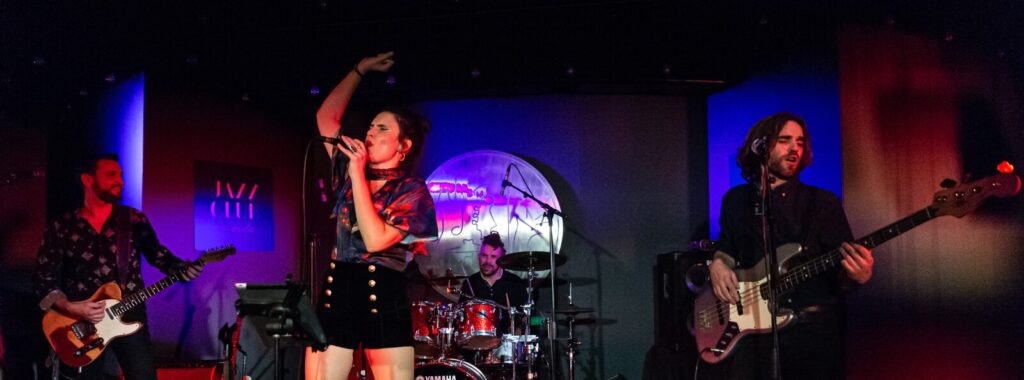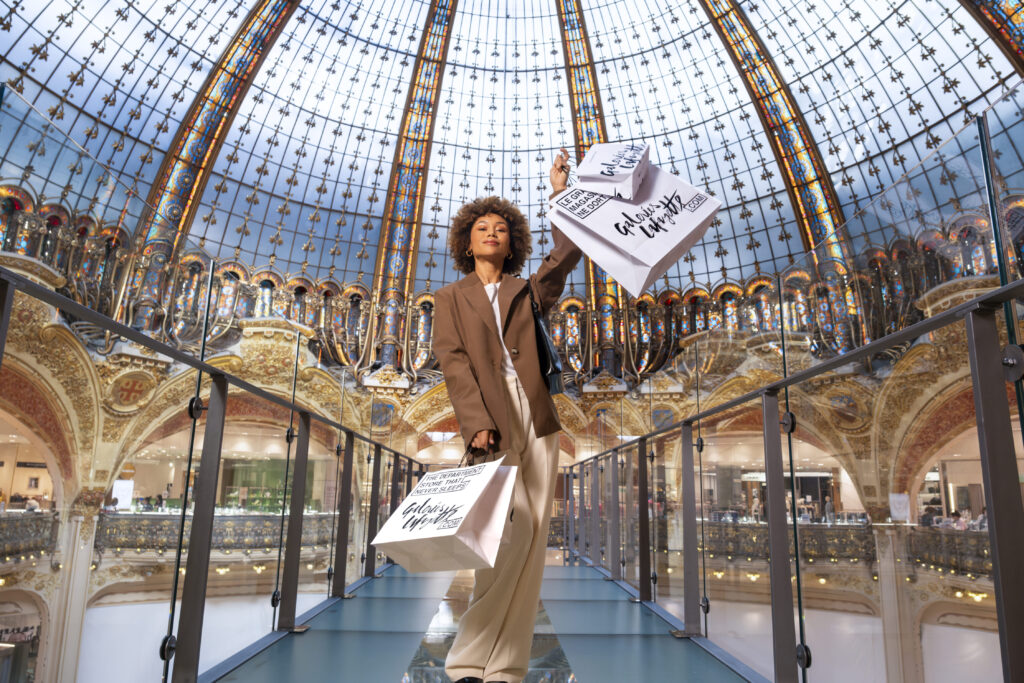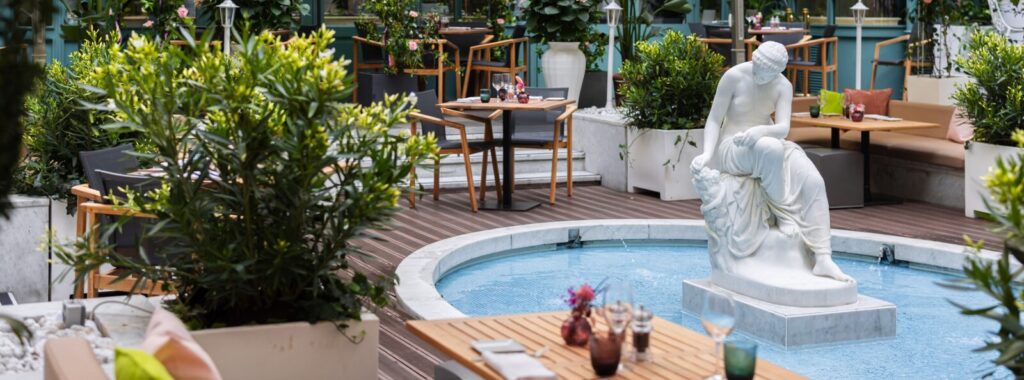Culture and heritage
The remarkable tale of Galeries Lafayette begins in the 19th century. The journey of this newcomer to the department store scene is punctuated by audacity and modernity at every turn. And this is its story.
PROMISING BEGINNINGS OF A PARISIAN SHOP
In 1893, two cousins from the Alsace, Théophile Bader and Alphonse Kahn, decided to open a shop selling novelty items in a small haberdashery, measuring just 70 m2, on the corner of rue La Fayette and rue de la Chaussée d’Antin in Paris.

Its location and the internal layout of the store, which encouraged customers to move along the aisles in straight lines, led to its name “Aux Galeries Lafayette”. Whilst the venture was a bit of a gamble, the store was in the perfect location near to the Opera and the Grands Boulevards. Crowds of Parisians and visitors from out of town spilled out of the neighbouring Saint-Lazare railway station, attracted by the businesses in the area.
In 1896, the company bought the whole building at number 1, rue La Fayette followed in 1903 by numbers 38, 40 and 42 on Boulevard Haussmann, as well as number 15, rue de la Chaussée d’Antin. The early years of the business were motivated by this “bricks and mortar strategy”, which resulted in an impressive acquisition of premises. All this was strengthened by its architecture, making it perfectly suited to the needs of commerce.
Théophile Bader entrusted the first major refurbishments of Boulevard Haussmann, completed in 1907, to architect Georges Chedanne. It was only really in 1912, however, spurred on by his apprentice Ferdinand Chanut, that the store began to take on a new dimension.
“A LUXURY BAZAAR”
The flagship Galeries Lafayette store was unveiled in all its glory at its inauguration in October 1912. Théophile Bader dreamed of creating a “luxury bazaar” where the sheer abundance and luxury of the merchandise on offer would wow the crowds! Golden light, filtered through the domed roof, would flood the grand hall and set the products aglow. The gamble had paid off.
Ferdinand Chanut called upon great artists from the École de Nancy to decorate this magnificent building in the style of Paris Art Nouveau. The banister of the magnificent staircase, inspired by the Paris Opera House, was designed by Louis Majorelle, who is also credited with the ironwork featured on the balconies. The dome, rising to a height of 43 metres, soon became the iconic symbol of Galeries Lafayette. Master glass-maker Jacques Gruber was responsible for designing the Neo-byzantine style stained glass windows.

The sales floor had suddenly doubled in size, but the innovations didn’t stop there! A tea room, reading room and smoking room were then added to complement the 96 existing departments. As more department stores began to appear, shopping was becoming a leisure activity. At the very top of the building, the rooftop terrace offered a panoramic view of Paris. The store began organising special events much to the delight of an entertainment-hungry clientèle, including the now famous rooftop landing by Jules Védrines in 1919. The aviator was fined for flying too low over Paris, but gained lifelong notoriety as the first ever rebel in aviation history.
The window displays have always been instrumental in setting the scene in the sales departments, with aspirational designs to tempt customers into the store. A vocation which has stood the test of time…
CELEBRITIES STAYING IN PARIS CAME TO GALERIES LAFAYETTE
The Haussmann department store is the second top tourist attraction, after the Eiffel Tower. It has become one of the must-see “greats” in the world. The store has hosted the likes of the Duchess of Windsor, Begum, the wife of the Aga Khan and in March 1960, right in the middle of the cold war, Mrs. Khrushchev. When she saw the escalators, she is said to have exclaimed: “It’s just like the Moscow underground!” In more recent times, the store has also welcomed Bill Clinton and Prince Charles, who opened the London exhibition.
“THE BEST MERCHANDISE IN ALL OF PARIS”
From the very beginning, Galeries Lafayette has remained true to its vocation: to serve up fashion and innovation. To stand out from his rivals, Théophile Bader wanted to make sure that the latest fashions would be available to all. With this in mind, he set up and acquired production facilities to make clothing exclusively for Galeries Lafayette under its own private label.
He was also keenly aware that fashion and customers’ tastes would constantly be changing. The Galeries Director devised an ingenious strategy to make sure the store was always up-to-date. He took himself off to the races and the opera, accompanied by a designer, who would discreetly copy the most stylish outfits designed by the most famous couturiers. Adjustments were made here and there and the outfits put into production as quickly as possible.
Fashion for the masses had arrived and it was an instant success. Very soon, everyone was hurrying along to Galeries Lafayette, from the wealthy bourgeoisie to working class seamstresses, known as “midinettes”, young women who only ever had time to grab a quick snack in their lunchbreak! A vast banner appeared, draped across the store façade on rue La Fayette, announcing: “Galeries Lafayette, the best merchandise in all of Paris.”
GROWTH AND DIVERSIFICATION: MENSWEAR AND HOME ITEMS
The store continued to grow and expand its product range, adding menswear, furniture, toys and tableware departments to its more traditional ranges.

Unwavering in their mission to make design accessible to all, Galeries Lafayette extended its already firm commitment to fashion, to the world of applied arts and design. In 1922, the department store opened “La Maîtrise” applied arts workshops under the artistic direction of Maurice Dufrêne. The aim of these workshops was to produce “works” (furniture, fabric, carpets, wallpaper, pottery etc.) accessible to budgets both large and small. Designers and twin brothers Jean and Jacques Adnet were amongst the first collaborators.
Despite the recession in 1929, Galeries Lafayette embarked on further expansions on the Boulevard Haussmann. In 1932, the flagship store was renovated by transatlantic liner architect Pierre Patout, in Art Déco style, with the addition of René Lalique bow windows.
Between 1941 and 1944, Galeries Lafayette was “aryanised”: its founders were ousted during the Occupation and the business placed under the administration of the Vichy government until the Liberation. In the aftermath of the Second World War’s bleak years, the business began to stage an economic recovery.
NEW BUSINESS MODEL
To meet the challenges of the post-war period, Galeries Lafayette underwent a complete makeover. The flagship store kick-started its modernisation by unveiling the highest escalator in Europe, in the Christmas of 1951. Shortly afterwards, the interior halls were phased out of operation and, between 1957 and 1959, the building was raised by two more floors.
Architectural modernisation was accompanied by expanding the product range, thanks to setting up a design office in 1952, creating the post of Fashion Director, sourcing products from abroad and launching new promotions. This new growth phase also saw the store play host to large international exhibitions. The first, in May 1953, was dedicated to “The Best of Italian Manufacturing”. Many more were to follow: “The U.S.A.” in 1961, “Africa” in 1972, “The USSR” in 1974 and also “Faces of India” in 1995.
The accessibility of design for all remained the company’s key focus and it went on to devise the “Festival of French Design” in 1954. The festival included an awards ceremony rewarding “good taste at good value for money, instead of bad taste at high prices”.
Other events subsequently proved to be firm favourites with its customers like the classic “3J” promotion. Launched on Saturday 4th October 1958, the store organised “A Day like no other”. It was a huge success and from October 1959 onwards, became known as “3J”.
In the early sixties, young designers began launching their ready-to-wear lines, sitting between haute couture and traditional tailoring. Each season Galeries Lafayette would showcase these new talents by providing them with small boutiques or concessions in the store. The first designer to hit the big-time was Laura, in 1962, which later went on to become Sonia Rykiel. Then it was the turn of Daniel Hechter, Pierre Cardin, Cacharel, Yves Saint-Laurent and Dorothée Bis.
LAFAYETTE 1, 2, 3
In 1969 a new store was opened on the other side of rue de Mogador, initially dedicated to young fashion and christened “Le Club 20 Ans”. For the first time, this club gathered together several different product ranges (clothing, pharmacy, music) embodying this particular lifestyle. Lafayette 2 was then taken over by men’s fashion, and later expanded with the addition of Lafayette Food & Drink in 1990. This is how Galeries Lafayette became the first “urban facilities centre”, bringing together boutiques, customer services, parking and direct access to the underground.
In 1974, a new chapter began with the removal of the legendary central staircase and then, a decade on, the central ground floor was reconfigured to make way for high-end boutiques.
In 1980, Galeries Lafayette created its “Fashion Festival”. Right up until 1999, the “Festival Oscars” would select the best designs created for Galeries Lafayette, and invite prestigious artistic directors to stage their shows. The list of famous names kept on coming: Karl Lagarfeld, Robert Wilson, Jérôme Savary, Marie-Claude Pietragalla, David LaChapelle, etc. In 1984, the store celebrated the opening of its designer department with its “France has got talent” exhibition, which welcomed Azzedine Alaïa, Jean-Paul Gaultier, Thierry Mugler and Jean-Charles de Castelbajac.
In 2001, the brand went even further upmarket and enlisted the services of Jean-Paul Goude to manage its public relations. His first advertising campaign “The adventures of Laetitia Casta in the land of Galeries Lafayette”, marked the beginning of a long and fruitful relationship. The photographer would go on to breathe new life into the brand with his nonconformist campaigns, always embodying Galeries Lafayette’s core values.
In 2004, the Marks and Spencer store on Boulevard Haussmann was transformed into Lafayette Maison, following the company’s purchase of all Marks and Spencer stores in France in 2001. Since then, Galeries Lafayette has proudly enjoyed a triple presence on the Boulevard Haussmann.

SERVING DESIGN: FREE-ENTRY ART GALLERY
Galeries Lafayette has long enjoyed strong links with the worlds of fashion and contemporary design. The Haussmann department store regularly hosts prestigious events, showcasing key designers of the moment as well as introducing its customers to artists whose work has endured the test of time.
In 2001, the Galeries Lafayette group decided to cement its links with contemporary design by creating the Galerie des Galeries, a free-entry art gallery on the first floor of the store, dedicated to exhibiting the cross-over between art, fashion and design.
Acutely aware of the added value represented by design, but also of its own role in making beauty accessible to all, Galeries Lafayette continues this commitment through numerous sponsorship activities. The store supports a number of institutions committed to supporting the artists of today including the Pompidou Centre, the Museum of Modern Art and the Villa Noailles in Hyères.
GALERIES LAFAYETTE HISTORY AND ARCHITECTURAL HERITAGE
Galeries Lafayette has remained a family business for five generations. It has transcended time, war and financial crisis to prove its unrivalled capacity for innovation.
In 2008, the management of the Group took the initiative to create a Heritage Department, with the aim of keeping the Group’s rich history alive, encouraging reflection on its true identity and strengthening the bond between the present and future organisation, and its history.
The department’s main objective is to preserve, conserve and highlight the architectural heritage of the Group and its historical archives, which are available for public viewing by appointment. These archives retrace the complete history of the Group in all its complexity and unique originality.





